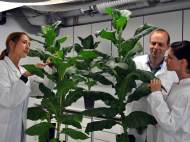Modifying tobacco plants to prolong their life and biomass
 The legend about the fountain of youth has been around for thousands of years, appearing in early records of various cultures around the world. Unlike Ponce de León, who searched for the fountain of youth when he traveled to what is now Florida back in 1513, a group of researchers from the Fraunhofer Institute for Molecular Biology and Applied Ecology (Fraunhofer IME) in Münster searched for a way to prolong the life of plants, thus enabling greater biomass yield.
The legend about the fountain of youth has been around for thousands of years, appearing in early records of various cultures around the world. Unlike Ponce de León, who searched for the fountain of youth when he traveled to what is now Florida back in 1513, a group of researchers from the Fraunhofer Institute for Molecular Biology and Applied Ecology (Fraunhofer IME) in Münster searched for a way to prolong the life of plants, thus enabling greater biomass yield.
Tobacco plants grow to their height of 1.5 to 2 meters (4.5 to 6 feet) for around three to four months. After that period the plant blossoms and dies. Fraunhofer IME researchers managed to find tobacco plant’s very own “fountain of youth”, by locating a genetic switch which prevents the plants to shift from blooming to flowering. This alteration enables the plant to stay young for years and grow without limits, and it also prevents the plant’s deterioration with age.
“The first of our tobacco plants is now almost eight years old but it still just keeps on growing and growing”, said Professor Dirk Prüfer, head of the Department of Functional and Applied Genomics at the Fraunhofer IME. “Although we regularly cut it, it’s six-and-a-half meters [21.3 feet] tall. If our greenhouse were a bit higher, it would probably be even bigger. Its stem is already ten centimeters [4 inches] in diameter.”
Whereas normal tobacco plants the leaves grow from the bottom of the stem turn yellow and drop off after a relatively short while, leaves of the tobacco plant designed at the Frauhofer IME stays healthy and green. This is why the scientists have christened their modified plant species “forever young”.
After researchers modify the expression of a certain gene, they manage to delay the plant’s flowering. The next step involves use of a bacterium to insert the modified gene back into the plant. The role of the bacterium is to act as transport for the modified gene. Aside prolonging lifespan and growth of the plant, the approach could be used to control plant reproduction. Preventing plants from flowering means that modified plants can’t produce seeds or pollen, thus leading to easier control and planning of their extension into the environment.
In the future, the researchers want to go further and be able to disable plant’s growth limits using chemical mutagenesis. This process involves using chemical additives to alter the DNA sequence of the seed itself, thus enabling development of new plant cultures that would no longer need genetic modification.
“But in order to be able to do that, we first need to gain a better understanding of the deregulation of genes”, said Prüfer, who hopes cultivation experiments might begin next year. “If we want to guarantee security of supply for foodstuffs and plant-based raw materials, the yield per hectare will have to double by 2050, claims the German Bioeconomy Council. This new technology brings us a great deal nearer to that target.”
The principle is transferable and it could be used on other kinds of plants. At the moment, Fraunhofer IME researchers are working on behalf of a Japanese chemical company in order to modify potato plants. They use their knowledge to enable greater yield of biomass from the crops. While this finding could serve to increase the biomass of some plants, it is only likely to deliver success as long as the flowers of the plant that needs to be modified play no significant role.









Leave your response!